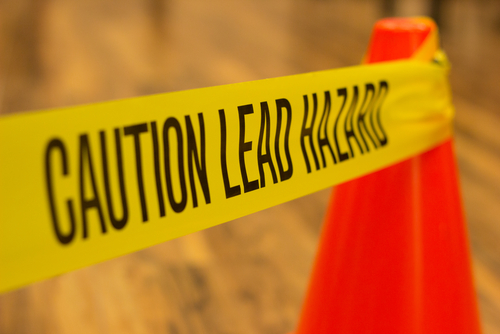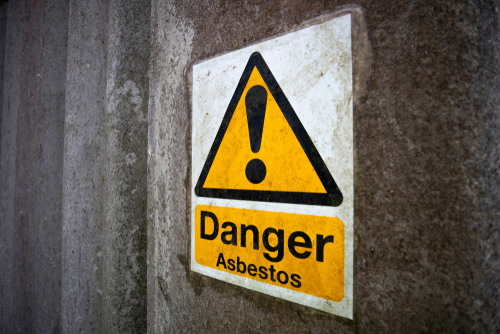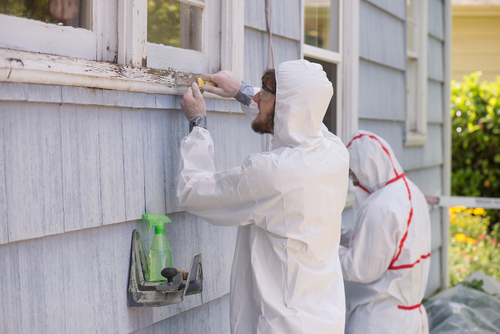The health and safety of all rental occupants should be a top priority for all landlords and property managers. After all, one of property owners’ most critical legal responsibilities is to provide a safe and habitable home for each tenant. It’s essential to know about the dangers of lead paint and asbestos and how to handle these potential hazards in older rental properties. Today, we’ll go over how to identify some of these hazardous materials along with landlord responsibilities for lead paint and asbestos.

Contents of This Article:
- What Is Lead Paint?
- What Is Asbestos?
- How to Identify Lead Paint and Asbestos in Your Property
- Landlord Responsibilities for Lead Paint and Asbestos
- Protect Yourself and Your Tenants With Property Management
What Is Lead Paint?
Lead paint, as you may be able to tell from the name, is paint that contains lead as one of its components. Lead was added to paint several years ago for its durability, colorfastness, and moisture resistance. Before the late 1970s, it was commonly used in buildings, homes, and other structures.
However, lead paint poses a serious health risk, especially in children. When lead paint deteriorates, it can create lead dust and flakes, which may be ingested or inhaled. Unfortunately, this can lead to lead poisoning, which can cause a range of health issues. For instance, it can result in developmental delays, learning difficulties, and in severe cases, it may lead to organ damage.
Due to the health hazards associated with lead exposure, using lead paint in residential buildings has been illegal since 1978. That said, in older properties, particularly those built before the 1970s, it’s crucial for landlords and Philadelphia property management to be aware of the potential presence of lead paint. Additionally, you’ll want to take appropriate precautions to prevent exposure, especially during renovations or repairs.
What Is Asbestos?
Asbestos is a mineral fiber that was once widely used in construction materials. It’s known for its excellent insulating, fire-resistant, and durable properties. That said, it consists of microscopic fibers that can easily become airborne, inhaled, and trapped inside the body. Unfortunately, when you inhale these hazardous fibers, they can pose serious health risks.

Exposure to asbestos has been linked to several respiratory diseases, including inflammation, scarring, and mesothelioma. Due to these severe health hazards, the use of asbestos in construction materials has been heavily restricted or banned in most instances.
However, in older buildings, especially those constructed before the widespread awareness of asbestos, it’s not uncommon to find some asbestos-containing materials in various forms. For instance, it may be in the insulation, flooring, roofing, or siding. That said, properly handling or removing asbestos in rental properties is crucial to protect tenants’ and their guests’ health and well-being.
How to Identify Lead Paint and Asbestos in Your Property
When you own rental properties, especially ones that were built before the 1970s, it’s crucial to know how to identify lead paint and asbestos. That said, both of these materials can be hard to see with the naked eye, so it’s important to know the signs and where to look.
Where to Find Lead Paint

According to the United States Environmental Protection Agency (EPA), lead paint in homes built before 1978 is most commonly found in areas such as:
- Around windows and window sills
- Stairs, railings, and banisters
- Doors and door frames
- Porches
- Exterior trim
Although it can be difficult to identify lead paint by just looking around, you may reach out to a qualified vendor to perform a lead test. After all, knowing about this potential hazard can help ensure you keep tenants safe and comply with federal and state disclosure requirements.
How to Identify Asbestos
Like lead paint, it’s hard to detect asbestos with the naked eye. However, it helps to know that older buildings have a higher chance of containing these products. Specifically, looking out for tiles, insulation, and other flooring materials is important. You may also find asbestos in roofing materials, plumbing, siding, and fiber cement sheets.
If you’re wondering what asbestos looks like or how to identify it throughout the materials in your property, it may be quite difficult. That said, asbestos is naturally white, brown, or blue, so spotting insulation in these colors may be more dangerous than the typical pink colors. However, it’s most dangerous when airborne, so disturbing products containing asbestos should be avoided.
Ultimately, the best way to identify asbestos in your rental property is by hiring a professional who can help test the building materials. Then, if asbestos is found in your property, you’ll want to contact a removal specialist to ensure safety throughout the home.
Landlord Responsibilities for Lead Paint and Asbestos
In 1992, Congress passed the Residential Lead-Based Paint Hazard Reduction Act to protect families from dangerous lead exposure. As part of the law, individuals who sell or lease homes built before 1978 have certain disclosure responsibilities. For instance, here are some of the requirements per the Residential Lead-Based Paint Hazard Reduction Act.
- Safety Information- Supply tenants with an EPA-endorsed informational pamphlet on handling lead-based paint hazards. This guide helps tenants to recognize and manage potential lead-based paint risks effectively.
- Disclosure- Landlords or property owners must disclose any knowledge of lead-based paint or lead-based hazards throughout the home. Additionally, provide the location and current condition of the affected surface.
- Lead Records- If lead paint is present in the home, landlords must make any documentation, reports, or test results available to tenants.
- Lease Attachments- Landlords or property managers should include an attachment or lease clause addressing the risks of lead-based paint. Additionally, have all tenants and landlords date and sign the document or clause to ensure all the necessary notification requirements.

Unlike the federally-required disclosures of lead-based paint hazards, there are no specific landlord disclosures regarding asbestos in a rental property. However, landlords must provide a safe and habitable environment for tenants, which may include taking action against asbestos.
Each tenant has a right to live in a rental unit that meets basic health and safety standards, including a home free of significant health hazards, like asbestos.
If a landlord fails to acknowledge or disclose harmful asbestos contamination, they may be liable for tenant injuries. For instance, a court may find them responsible for medical expenses, lost wages from being out of work, decreased quality of life, etc.
Protect Yourself and Your Tenants With Property Management
Knowing the hazards of lead paint and asbestos can help keep you and your tenants safe and healthy. Additionally, the first step in protecting yourself against legal action is knowing your responsibilities regarding lead paint and asbestos. If you’re renting out an older property that may contain these harmful substances, giving your tenants the proper disclosures and information is crucial to help keep them safe.
That said, if you need help inspecting properties and communicating important disclosures with tenants, you may consider professional property management.
Need More Advice? contact us today!
Bay Property Management Group offers comprehensive rental management services, meaning we’ll take care of the entire rental process, from marketing to tenant screening, rent collection, maintenance, and more. If you’re looking for management services in or around Baltimore, Philadelphia, Northern Virginia, or Washington, DC, contact BMG today!
